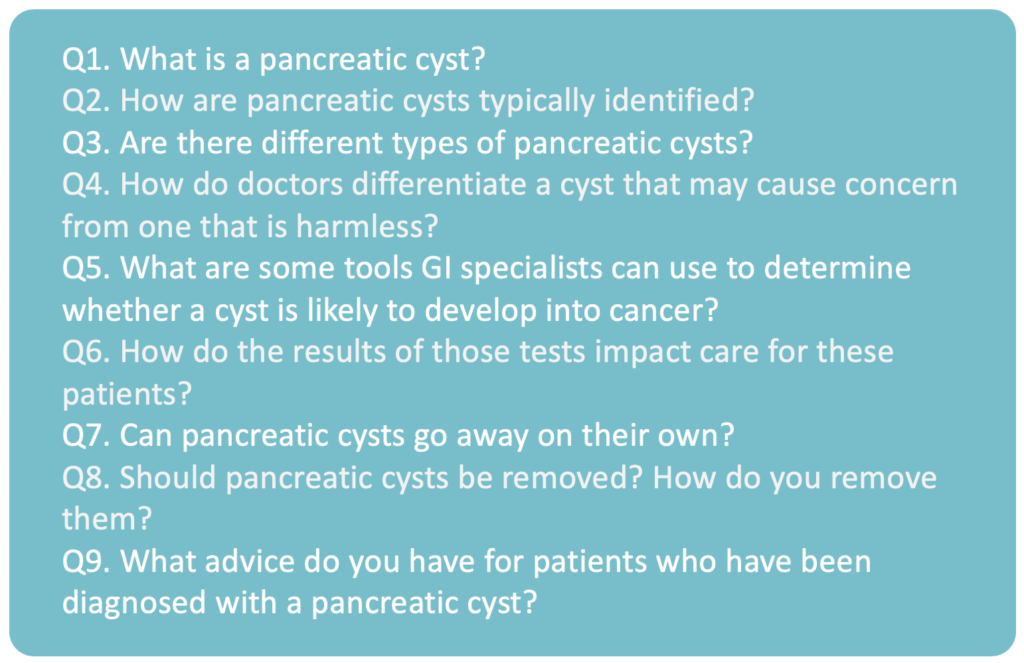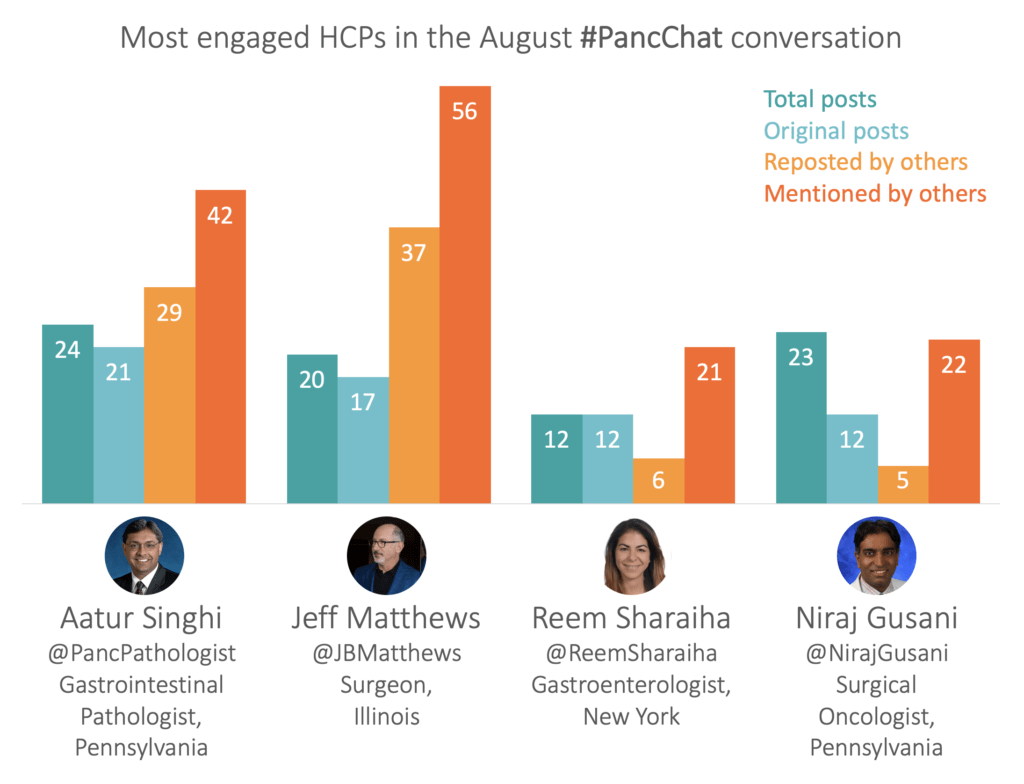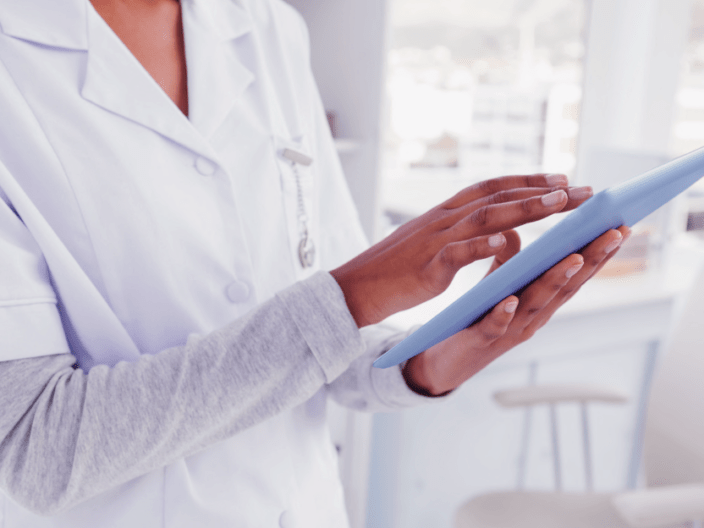Within the broader pancreatic cancer conversation on Twitter, there is a Twitter chat called #PancChat that is facilitated by Let’s Win! Pancreatic Cancer (Let’s Win! PC). The purpose of #PancChat is to ‘provide relevant, credible, and timely information to the pancreatic cancer community. Each month, questions about a certain topic relating to pancreatic cancer are asked, and consequently answered by various healthcare professionals (HCPs), who give their own views and engage in discussion with peers. The online platform allows for other stakeholders, including patients and medical students, to learn from top oncologists, pathologists, and surgeons in the therapy area.
CREATION Pinpoint® isolates the voice of healthcare professionals online and, in August 2019, identified 60 HCPs from across the world who contributed a total of 239 tweets to the #PancChat conversation.
Hosted on the 21st of August 2019, the theme was pancreatic cysts. Over the course of an hour Let’s Win! PC released nine questions on this theme, each of which was discussed before the next question was posted.

The question with the most responses was Q8: ‘Should pancreatic cysts be removed? How do you remove them?’. This created a significant conversation around surgery, with one surgeon, Jeff Matthews, emerging as one of the most engaged authors in the discussion.
#PancChat contributors offer second opinions
HCPs were considering surgery evaluation (deciding whether or not a cyst needed to be removed due to cancer risk) as well as over treatment (unnecessary resections).
Aatur Singhi, a pancreatic pathologist from Pennsylvania, responded to a tweet saying that pancreatic cysts may be removed if they are larger than 3cm. He pointed out that cysts don’t always need to be removed, especially if benign and asymptomatic. This kind of discussion is key to the success of medical Twitter chats such as #PancChat in fulfilling their purpose to educate. Dr Singhi’s comment was a second opinion to one provided by a research group previously on the thread, showing to those who were reading the conversation the various options that are available for treatment, as well as the considerations that should be made.
Jason Denbo, a surgical oncologist from Florida, said that a pancreatic cyst should be removed depending on various factors, highlighting a previous tendency to unnecessarily remove them. This again reflects that there are options regarding treatment, suggesting the amount of consideration required before surgery.
The most reposted tweet in the surgery conversation (and the whole month’s #PancChat) was from surgeon Jeff Matthews in Chicago. Whilst he was not directly answering one of the prescribed questions, contextually, he was referring to the discussion around cyst resection.
The tweet, claiming “It’s hard to make an asymptomatic patient better.”, received 49 retweets, 23 of which were from HCPs worldwide. Many responded in agreement, and within the comments he clarified his point on recommending a significant intervention.
Matthews’ patient-centred responses were celebrated by his peers, as well as patients involved in the online discussion.
Patient advice
The final question was related to patient advice given by HCPs; ‘What advice do you have for patients who have been diagnosed with a pancreatic cyst?’ This question received only 7 responses, yet they were all along the same vein, reminding patients not to be scared. In her tweet, gastroenterologist Reem Sharaiha, mentioned specific pancreas cyst programs. These are, as is suggested, programs at larger hospitals with interdisciplinary specialists, who have researched and trained in the treatment of pancreatic cysts.
Whilst HCPs suggested that these programs are the best for patients in terms of outcomes, one issue raised in this conversation was that not all patients will have access to such multidisciplinary teams.
Whilst recognising this issue, gastrointestinal oncologist, Shaalan Beg, highlighted the benefit of #PancChat; that it is an educational resource, compiled by experts, that both patients and HCPs can learn from and thus seek out better evaluation, testing and treatment of pancreatic cysts.
Digital opinion leaders
Having previously identified 5 Digital Opinion Leaders (DOLs) in the online pancreatic cancer conversation, three new HCP influencers emerged in this #PancChat discussion. Most notable, two surgeons arose, likely due to the surgical nature of the discussion.

Aatur Singhi, an HCP we previously labeled as a DOL in the pancreatic conversation is a specialist in pancreatic pathology. His expertise was well received by others online and he contributed the most posts in this month’s #PancChat. His most shared post was a simple resource showing the difference between two types of cyst.
Jeff Matthews, as mentioned above, took a more patient-centric approach than his peers, reminding them of the importance of shared decision making when it comes to treatment choice. His thread answering Q8 brought out considerations that other HCPs had not yet mentioned. In agreement with Matthews, others added their own take on HCP-patient relationships.
Reem Sharaiha this month made her first contributions to #PancChat and after she was introduced as a guest by facilitator Dr Allyson Ocean, she was actively involved in the conversation.
Niraj Gusani is the most followed of the top HCPs in this month’s #PancChat, with 11,200 followers on Twitter, 27% of which are other HCPs. He brought his clinical expertise to the conversation, referencing his experiences with patients and diagnosing pancreatic cysts. This example shows how Twitter, and Twitter chats specifically, can be educational in a real-world setting when HCPs share patient cases. It is common for HCPs on Twitter to ask the opinion of their peers if they’re unsure of a diagnosis or treatment route.
CREATION’s analysis of August’s #PancChat shows the breadth of HCP conversation happening online. In even a singular topic within one therapy area, HCPs from all backgrounds and specialities can unite to share their experiences, as well as educate themselves and others.
Twitter chats are common practice across medical Twitter, with different hashtags for each therapy area. A popular variation of a Twitter chat is a “journal club”, allowing contributors to discuss new research in their field and share opinions on new products. #RheumJC unites HCPs interested in rheumatology and #NephJC for nephrology, each of these are moderated and ultimately can contribute to professional development. Twitter users also compliment these events and always look forward to the next, eager to engage in discussion with their global peers.
To access CREATION’s full, year long analysis, you can sign up to receive our retrospective study of pancreatic cancer in the US, and ongoing tracking such as this. To learn more about leveraging CREATION’s unique HCP insights to understand what HCPs think about anything at all, get in touch.
 By Mary Kangley
By Mary Kangley 



